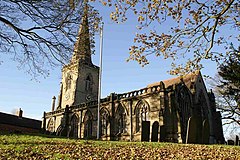Stoke Golding
| Stoke Golding | |
|---|---|
 Parish church of Saint Margaret |
|
| Stoke Golding shown within Leicestershire | |
| Population | 1,684 (2011) |
| OS grid reference | SP399973Stoke Golding |
| District | |
| Shire county | |
| Region | |
| Country | England |
| Sovereign state | United Kingdom |
| Post town | NUNEATON |
| Postcode district | CV13 |
| Dialling code | 01455 |
| Police | Leicestershire |
| Fire | Leicestershire |
| Ambulance | East Midlands |
| EU Parliament | East Midlands |
| UK Parliament | |
Stoke Golding is a village and civil parish in the Hinckley and Bosworth district of Leicestershire, England, which lies in the heart of England, in South West Leicestershire, close to the Leicestershire county border. According to the 2001 census the total population was 1,721, living in just over 700 houses. The population at the 2011 census was 1,684 living in 723 households. The village is 16 miles from the City of Leicester, about three miles north-west of the market town of Hinckley, and 4 miles along scenic country lanes from the village of Fenny Drayton, the birthplace and childhood home of George Fox (the founder of the worldwide Religious Society of Friends (Quaker) movement). The village is bordered on one side by the Ashby Canal, well-used for recreational purposes.
Stoke Golding's unique historical claim to fame is that in 1485 the people of the village witnessed the rural coronation of Henry VII, the first Tudor monarch. His defeat of King Richard III, last of the Plantagenets, at the Battle of Bosworth marked the end of the Wars of the Roses and heralded the accession to the throne of the Tudor dynasty of three Kings and two Queens. So doing Stoke Golding claims to be the "Birthplace of the Tudor Dynasty".
After Henry Tudor was victorious over Richard III at the Battle of Bosworth, which took place in the healthy marshland known as the Redemore between Stoke Golding, Dadlington, Shenton and Sutton Cheney. Henry's entourage retired to hilly ground near the village of Stoke Golding. Here the impromptu coronation of King Henry VII was performed with a circlet by tradition retrieved from a nearby thorn bush. This area became known as Crown Hill and Crownhill Field.
Historical local accounts of the Battle of Bosworth field tell of the villagers climbing on to the battlements of the church of St Margaret of Antioch to view the bloody battle on 22 August 1485. The window sills of the Church show grooves which legend has it were caused by the soldiers sharpening their swords and axes on the eve of the battle. After the fighting large pits were dug around Stoke Golding and the villages of Dadlington and Fenny Drayton, the nearest villages to the complete site of the battlefield, for the burial of the dead. King Henry VII then rewarded some of his followers and Knighted the more senior of his supporters.
...
Wikipedia

